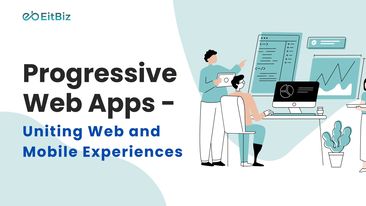Progressive Web Apps – Uniting Web and Mobile Experiences
Did you know?
Recent research shows that nearly 92% of their mobile time is spent in apps while only 8.1% browse the internet.
Sounds surprising, doesn’t it?
Thus, building a solid web app is incredibly important in such a scenario to capture your target audience.
Progressive Web Apps (PWAs) are combining the seamless experience of mobile apps with expansive reach and web accessibility.
Their popularity lies in that they deliver a smooth user experience and high engagement levels.
In this blog, we’ll take a deep dive into the PWAs, their benefits, the tech used, and a lot more!
Let’s dive in!
Understanding Progressive Web Apps (PWAs)
Progressive Web Apps (PWAs) is a ground-breaking approach to web applications. It provides functionality akin to native mobile apps while remaining accessible through web browsers. Built using modern web technologies like HTML, CSS, and JavaScript, PWAs function seamlessly across all devices and platforms.
One of the standout features of PWAs is their capability to operate offline or in low-connectivity environments. It ensures uninterrupted access to content and features regardless of internet speed. This resilience makes PWAs particularly appealing in regions with unreliable internet connections or for users on the move.
Moreover, PWAs excel in their adaptability to diverse devices and screen sizes. With responsive design principles, PWAs adjust their layout and functionality to suit the screen dimensions of smartphones, tablets, or desktops. Furthermore, this adaptability enhances the user experience, promoting engagement across a wide range of devices and settings.
But now the question arises- How is it better than native web apps?
- A Progressive Web App Development (PWA) can enhance speed performance by an impressive over 62%, unlike its previous mobile site iteration.
- Pages utilizing PWA technology load between two to four times faster than traditional web pages.
- The loading time for PWA sites averages a swift 2.75 seconds. Moreover, it shows their ability to deliver content swiftly and efficiently to users.
Now, that you have understood the popularity of PWAs, it’s time to unwrap its benefits!
Key Features and Benefits of PWAs
- Swift Performance
One of the key features and benefits of PWAs is that it offers quick and hassle-free performance. The frustration of waiting for a website to load, especially on slower networks, is a thing of the past. Engineered for speed, PWAs load swiftly thanks to their lightweight design and efficient resource utilization.
- Network Resilience
PWAs ensure that your clients’ online services remain steadfast and accessible regardless of network conditions. They provide a resilient digital connection, which empowers customers to engage with content seamlessly even with limited connectivity. In addition, it mirrors the reliability of your client’s businesses which fosters trust and continuity in the digital realm.
- Network Independence
PWAs make sure your clients’ online services are strong and useful, so their customers are never left without what they need. Irrespective of your customers’ location or internet speed, they can still access your clients’ content with just a click. Moreover, it’s like a reliable digital lifeline that shows how trustworthy your clients’ businesses are.
- Efficient Storage and Data Usage:
Ever worried about installing an app because you’re concerned about it taking up too much space on your device? Well, PWAs can help with that. They use up a lot less storage space compared to regular apps because they don’t need big installations.
- Cross-Platform Compatibility:
PWAs are made using web technologies that can run on different platforms. It allows progressive apps to work on many devices and operating systems. Due to this, it will reduce the need to make separate apps for each platform.
Tools And Technologies Used for PWA Development
To create a successful Progressive Web App (PWA), it’s essential to utilize the appropriate tools and technologies. Below are key components commonly employed in PWA development:
- Service Workers: These background scripts enable PWAs to operate offline, manage caching, and deliver push notifications.
- Web App Manifest: A JSON file specifying the app’s behavior when added to the home screen, including icons, colors, and display settings.
- Responsive Design Frameworks: Frameworks such as Bootstrap, Foundation, or Materialize CSS ensure that PWAs are visually appealing and functional across various devices.
- IndexedDB: This browser database stores structured data, enabling PWAs to function without an internet connection by accessing locally stored information.
- Push Notifications APIs: Implementing push notifications keeps users engaged, even when they’re not actively using the app.
- Lighthouse: An open-source tool provided by Google for evaluating PWA performance, accessibility, and other aspects, aiding developers in optimizing user experience.
- PWA Builder: Tools like Ionic, React, Vue.js, Angular, and PWA Starter Kits offer templates and pre-configured setups to streamline PWA development.
- Workbox: A Google-developed library that simplifies service worker and caching strategies. It offers ready-made solutions for common PWA tasks like caching and push notification handling.
- App Shell Architecture: This design pattern loads essential UI and navigation elements first, enhancing the app’s speed and responsiveness.
Real-world Examples of Successful PWAs
Here are the examples of popular web apps.
- Twitter Lite: Its “Lite Version” provides a quick and lightweight experience, even on sluggish networks. By cutting down data usage and load times, it has attracted a wider audience.
- Starbucks: It allows users to explore the menu, personalize orders, and find nearby stores. With offline features, the app ensures a smooth experience, no matter the internet connection.
- Pinterest: It offers a visually engaging and responsive interface, enabling users to explore, save, and organize ideas. Its offline mode lets users access saved content even without internet access.
Final Thoughts
In summary, Progressive Web Apps (PWAs) represent a viable solution that bridges the divide between web and mobile experiences. Their cross-platform adaptability, offline capabilities, enhanced performance, and cost-effective development make them a compelling choice for businesses aiming to engage users and provide a seamless, personalized experience.





